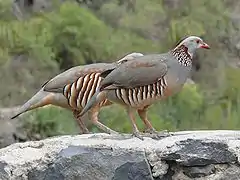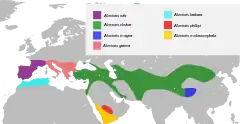| Alectoris[1] | |||||
| Kaup, 1829[2] | |||||
 Przedstawiciel rodzaju – góropatwa berberyjska (A. barbara) | |||||
| Systematyka | |||||
| Domena | |||||
|---|---|---|---|---|---|
| Królestwo | |||||
| Typ | |||||
| Podtyp | |||||
| Gromada | |||||
| Podgromada | |||||
| Infragromada | |||||
| Rząd | |||||
| Rodzina | |||||
| Podrodzina | |||||
| Plemię | |||||
| Rodzaj |
Alectoris | ||||
| Typ nomenklatoryczny | |||||
|
Perdix barbara Bonnaterre, 1790 | |||||
| |||||
| Gatunki | |||||
| |||||
| Zasięg występowania | |||||
 | |||||
Alectoris – rodzaj ptaków z podrodziny bażantów (Phasianinae) w rodzinie kurowatych (Phasianidae).
Zasięg występowania
Rodzaj obejmuje gatunki występujące w Eurazji i północnej Afryce[13].
Morfologia
Długość ciała 32–49 cm, rozpiętość skrzydeł 46–53 cm; masa ciała samców 445–850 g, samic 376–720 g[14].
Systematyka
Etymologia
- Alectoris (Alectornis): gr. αλεκτορις alektoris, αλεκτοριδος alektoridos „kura”, od αλεκτωρ alektōr, αλεκτορος alektoros „kogucik”[15].
- Caccabis: gr. κακκαβις kakkabis, κακκαβιδος kakkabidos „kuropatwa”[16]. Gatunek typowy: Perdix saxatilis Bechstein, 1805[uwaga 1].
- Rufipes: łac. rufus „czerwony, rudy”; pes, pedis „stopa”, od gGr. πους pous, ποδος podos „stopa”[17]. Gatunek typowy: Rufipes vulgaris S.D.W., 1835 (= Tetrao rufus Linnaeus, 1758).
- Erythropus: gr. ερυθροπους eruthropous, ερυθροποδος euthropodos „czerwonostopy”, od ερυθρος eruthros „czerwony”; πους pous, ποδος podos „stopa”[18]. Gatunek typowy: Tetrao rufus Linnaeus, 1758.
- Chacura: nazwa Chukor oznaczająca w hindi góropatwę azjatycką[19]. Gatunek typowy: Perdix chukar J.E. Gray, 1830.
- Pyctes: gr. πυκτης puktēs „bokser, wojownik”[20]. Gatunek typowy: Gatunek typowy: Perdix chukar J.E. Gray, 1830.
- Palaeocryptonyx: gr. παλαιος palaios „stary, starożytny”; genus Cryptonyx Temminck, 1815 (bezszpon)[21]. Gatunek typowy: †Palaeocryptonyx donnezani Depéret, 1892.
- Pliogallus: gr. πλειων pleiōn „większy, jeszcze”, forma wyższa od πολυς polus „dużo”; rodzaj Gallus Linaneus, 1758 (kur)[22]. Gatunek typowy: †Ammoperdix coturnoides Tugarinov, 1940.
- Plioperdix: gr. πλειων pleiōn „większy, jeszcze”, forma wyższa od πολυς polus „dużo”; rodzaj Perdix Brisson, 1760 (kuropatwa)[23]. Nowa nazwa dla Pliogallus Tugarinov, 1940.
- Proalector: gr. προ pro „blisko”; αλεκτωρ alektōr, αλεκτορος alektoros „kogucik”[24]. Gatunek typowy: †Palaeortyx miocaena Gaillard, 1938 (= †Palaeortyx edwardsi Depéret, 1887).
- Lambrechtia: Kálmán Lambrecht (1889–1936), węgierski paleontolog, ornitolog i etnograf[25]. Gatunek typowy: †Francolinus (Lambrechtia) minor Jánossy, 1974 (= †Palaeortyx edwardsi Depéret, 1887).
- Chauvireria: Cécile Mourer-Chauviré (ur. 1939), francuska paleontolożka[26]. Gatunek typowy: †Chauvireria balcanica Boev, 1997.
Podział systematyczny
Do rodzaju należą następujące gatunki[27]:
- Alectoris graeca – góropatwa skalna
- Alectoris chukar – góropatwa azjatycka
- Alectoris magna – góropatwa chińska
- Alectoris philbyi – góropatwa czarnogardła
- Alectoris barbara – góropatwa berberyjska
- Alectoris rufa – góropatwa czerwona
- Alectoris melanocephala – góropatwa arabska
Uwagi
- ↑ Podgatunek A. graeca.
Przypisy
- ↑ Alectoris, [w:] Integrated Taxonomic Information System (ang.).
- ↑ Kaup 1829 ↓, s. 180.
- ↑ Kaup 1829 ↓, s. 183.
- ↑ S.D.W.. Remarks conducive to the improvement of ornithological nomenclature. „The Analyst”. 3 (13), s. 33, 1835. (ang.).
- ↑ E. Blyth. Hewitson’s "British oology.". „The Analyst”. 5 (17), s. 89, 1836. (ang.).
- 1 2 B.H. Hodgson: Catalogue of Nipalese Birds, collected between 1824 an 1844. W: J.E. Gray: The zoological miscellany: to be continued occasionally. London: Published by Treuttel, Wurtz and Co., G.B. Sowerby, W. Wood, 1844, s. 85. (ang.).
- ↑ H.G.L. Reichenbach: Handbuch der speciellen Ornithologie. Dresden: Expedition der vollstandigsten Naturgeschichte, 1863, s. 89. (niem.).
- ↑ Ch. Depéret. Sur la faune d'Oiseaux pliocènes du Roussillon. „Comptes rendus hebdomadaires des séances de l’Académie des Sciences”. 114, s. 691, 1892. (fr.).
- ↑ M. Kretzoi. Pliogallus Gaillard 1939 és Pliogallus Tugariny 1940 (Pliogallus Gaillard 1939 and Pliogallus Tiigarinow 1940). „Aquila”. 59–62, s. 367, 1952–1955. (węg. • ang.).
- ↑ P. Brodkorb. Catalogue of Fossil Birds, Part 2 (Anseriformes through Galliformes). „Bulletin of the Florida State Museum, Biological Sciences Series”. 8, s. 316, 1964. (ang.).
- ↑ D. Jánossy. Upper Pliocene and Lower Pleistocene Bird Remains from Poland. „Acta Zoologica Cracoviensia”. 19, s. 540, 1974. (ang.).
- ↑ Z. Boev. Chauvireria balcanica gen. n., sp. n. (Phasianidae — Galliformes) from the Middle Villafranchian of Western Bulgaria. „Geologica Balcanica”. 27 (3–4), s. 71, 1997. (ang.).
- ↑ F. Gill & D. Donsker: Pheasants, partridges & francolins. IOC World Bird List: Version 8.2. [dostęp 2018-09-07]. (ang.).
- ↑ P.J.K. McGowan: Family Phasianidae (Pheasants and Partridges). W: J. del Hoyo, A. Elliott & J. Sargatal: Handbook of the Birds of the World. Cz. 2: New World Vultures to Guineafowl. Barcelona: Lynx Edicions, 1994, s. 485–486. ISBN 84-87334-15-6. (ang.).
- ↑ The Key to Scientific Names ↓, Alectoris [dostęp 2018-09-07].
- ↑ The Key to Scientific Names ↓, Caccabis [dostęp 2018-09-07].
- ↑ The Key to Scientific Names ↓, Rufipes [dostęp 2018-09-07].
- ↑ The Key to Scientific Names ↓, Erythropus [dostęp 2018-09-07].
- ↑ The Key to Scientific Names ↓, Chacura [dostęp 2018-09-07].
- ↑ The Key to Scientific Names ↓, Pyctes [dostęp 2018-09-07].
- ↑ The Key to Scientific Names ↓, Palaeocryptonyx [dostęp 2018-09-07].
- ↑ The Key to Scientific Names ↓, Pliogallus [dostęp 2018-09-07].
- ↑ The Key to Scientific Names ↓, Plioperdix [dostęp 2018-09-07].
- ↑ The Key to Scientific Names ↓, Proalector [dostęp 2018-09-07].
- ↑ The Key to Scientific Names ↓, Lambrechtia [dostęp 2018-09-07].
- ↑ The Key to Scientific Names ↓, Chauvireria [dostęp 2018-09-07].
- ↑ Systematyka i nazwy polskie za: P. Mielczarek & M. Kuziemko: Plemię: Coturnicini Reichenbach, 1848 (wersja: 2020-07-21). [w:] Kompletna lista ptaków świata [on-line]. Instytut Nauk o Środowisku Uniwersytetu Jagiellońskiego. [dostęp 2020-08-19].
Bibliografia
- J.J. Kaup: Skizzirte Entwickelungs-Geschichte und natürliches System der europäischen Thierwelt: Erster Theil welcher die Vogelsäugethiere und Vögel nebst Andeutung der Entstehung der letzteren aus Amphibien enthält. Darmstatd: In commission bei Carl Wilhelm Leske, 1829, s. 1–203. (niem.).
- The Key to Scientific Names, J.A. Jobling (red.), [w:] Birds of the World, S.M. Billerman et al. (red.), Cornell Lab of Ornithology, Ithaca (ang.).
This article is issued from Wikipedia. The text is licensed under Creative Commons - Attribution - Sharealike. Additional terms may apply for the media files.